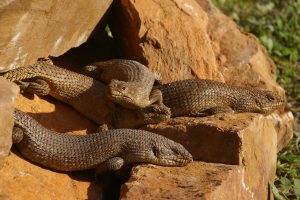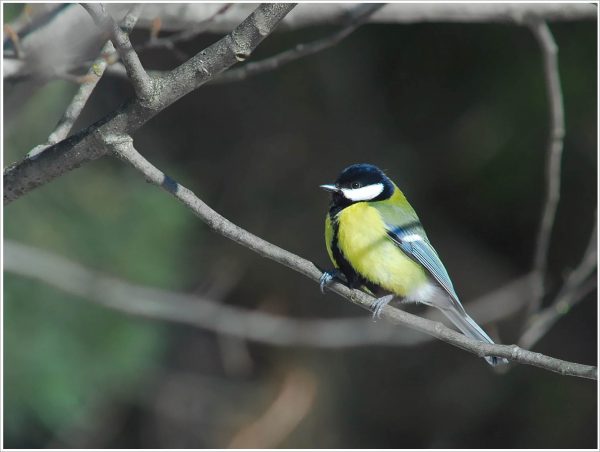Live bearing promotes the evolution of sociality
Some lizards and snakes tend to hang out in family groups, not unlike the more familiar social groups of birds and mammals. Our recent study, headed by Ben Halliwell and Geoff While and published in Nature Communications, show that the evolution of social grouping is much more likely to have happened in lizards and snakes that give birth to live young. There could be a number of reasons that transitions to sociality are more common for live bearing species.
The most obvious one – and the theoretical rationale behind this study – is that giving birth to live young makes interactions between parents and offspring more likely than in species that lay eggs. And interaction among kin, in turn, is what causes natural selection for group living.
Some lizards – in particular the Egernia – in fact have quite complex kin-based social structures. As expected, such groups have almost exclusively evolved in live-bearing lineages. Interestingly, egg guarding does not seem to have the same positive effect on the evolution of sociality. Maybe this is because the ecology needs to be right as well to select for delayed dispersal and parental tolerance of offspring. For the full story, please download the paper here.
Read More
Evolutionary adaptation to climate: same same, but different
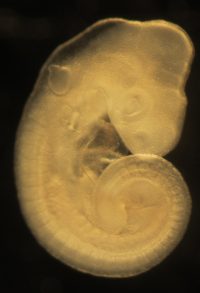
A new study published in Evolution – headed by Nathalie – reveals how embryonic gene expression patterns change as non-native lizards adapt to cool climate.
Populations adapting independently to the same environment provide important insights into the repeatability of evolution. In the 20th century, common wall lizards (Podarcis muralis) from southern and western Europe were introduced to England, north of their native range. We have previously shown that non-native populations of both lineages have adapted to the shorter season and lower egg incubation temperature by increasing the absolute rate of embryonic development.
In this new study, we show that embryos from non-native populations exhibit gene expression profiles consistent with directional selection following introduction. However, different genes are affected in lizards from France and Italy. The biological function of these genes are quite similar, though, and consistent with mechanisms that should speed up development. These results indicate that small populations are able to adapt to new climatic regimes, but the means by which they do so may largely be determined by founder effects and other sources of genetic drift.
Read More
Heredity in Evolutionary Theory
It may not have escaped your attention that biologists are taking a more inclusive view on heredity these days, regularly referring to epigenetic or behavioural inheritance, for instance. It is often difficult to understand what this means, however, or why it matters. Tobias and Heikki Helanterä take a closer look at heredity in evolutionary theory in a new book from Oxford University Press – Challenging the Modern Synthesis: Adaptation, Development & Inheritance, edited by philosophers of biology Philippe Huneman and Denis Walsh. A pre-print version of the chapter can be found here.
In evolutionary biology, there are arguably four main ways to think of heredity: as transmission of genes and other ‘particles’, as a phenotypic covariance, as transmission of information, and as the outcome of developmental processes. These are not mutually exclusive, and which one that is adopted or emphasized is partly a pragmatic decision based on the research question at hand (e.g., Tobias regularly makes use of all four), and partly a reflection of one’s conceptual framework (e.g., in some people’s minds heredity can only be genetic and strictly separated from development, and if you think otherwise you are either an idiot or, worse, a Lysenkoist in disguise).
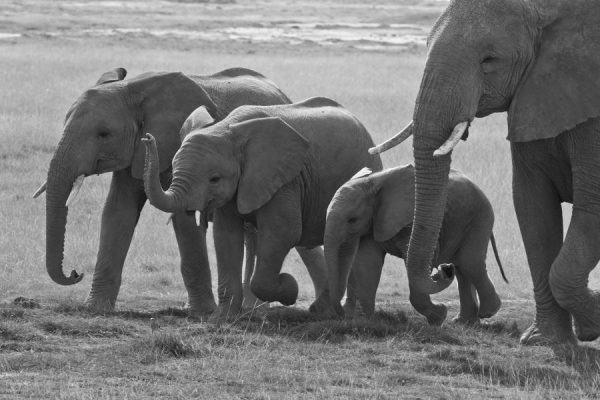
When empirical research reveals new mechanisms by which parents influence their offspring – like the persistence of DNA methylation from mother to offspring or offspring learning how to forage from their father – researchers naturally accommodate these findings according to how they think of heredity. But it also leads the odd biologist (and non-biologists) to question the coherence of her current conceptual framework, which is why ‘extra-genetic inheritance’ can be perceived as a challenge to the traditional view of evolution (i.e., the ‘modern synthesis’ – if you do not like this term, just think of a colleague who thinks that all fundamental problems in phenotypic evolution can/should be answered without referring to development). And, as we know, conceptual change can make some new research questions appear more interesting or relevant than they did before, whereas others may fade into oblivion.
Read MoreIlliam Jackson joins the group
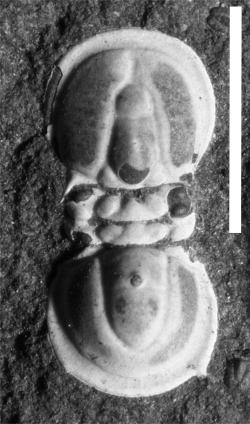
Target of illiams PhD work – Agnostus pisiformis fossil. Scalebar is 2 mm.
It is often pointed out that there is a strange gap between evolutionary biology and palaeontology. Particularly considering that it is hard to find something so obviously relevant to evolution as the fossil record… Anyway, we now hope to reduce this gap thanks to Illiam Jackson. Illiam did his PhD in palaeobiology in Uppsala under the supervision of Graham Budd (although he likes to point out that his first degree was in Biology). He joins us with a passion for morphometrics, and for making development relevant also to the study of fossils. Illiam will continue his work on plasticity and evolution of trilobite-ish arthropods here at Lund, but he will also – together with Nathalie Feiner – explore if developmental plasticity shapes adaptive radiation of lizards. Welcome Illiam!
Read MoreHighlights from ESEB 2017
This year’s European Society for Evolutionary Biology meeting was held in Groningen. ESEB is always a great opportunity to see old friends, learn new things, and – somewhat jealously! – see the progress on the most famous study systems in evolutionary biology, such as cichlids, Heliconius butterflies, and bird beaks. And progress there was. Among the most memorable were further evidence from the Seehausen group – presented by Joana Meier and others – that hybridization has played a creative role in fish evolution in both African and European lakes, and a tour-de force of Heliconius evolutionary genomics in a plenary by Chris Jiggins (there is a book, not only for butterfly lovers!). Hybridization was hot at the meeting so it was a shame that Yang was unable to join this year. Wallies were represented, however, by a nice talk on the ventral colour polymorphism by Pedro Andrade. Chances are they will make a big splash next year in Montpellier!
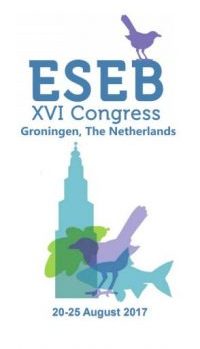
To be fair, ESEB has never been a hotspot for development and this year was no different. Manhattan plots abound, but there was generally little process-oriented research to allow us to connect genotype and phenotype. Exceptions included an excellent plenary by Renee Duckworth, where she demonstrated how to integrate proximate and ultimate causation to understand why organisms change over time or, in this case, why they may not do so. Another exceptional talk was delivered by Alex Badyaev, expanding on his recent papers on the evolution of carotenoid colouration in birds. Describing evolution as transitions between external and internal control in regulatory networks, this work demonstrated the potential for taking a comparative network approach to study innovation and diversification from a developmental perspective.
Other welcome islands in the sea of genomics of adaptation include Andreas Wagner’s plenary on innovation and modularity, or a talk by Christoph Thies from Richard Watson’s group who presented some refreshing ideas on evolutionary transitions in individuality and demonstrated how to capture this process formally. Plasticity and evolution was represented here and there, including an update on the spadefoot toad story by Ivan Gomez-Mestre.
Judging from the ESEB talks, evolutionary biologists are very interested in extra-genetic inheritance. Most talks – including a pretty well-attended symposium keynote by Tobias – revealed this interest to largely be about adaptive function, but with some nice links to life history and ageing (many thanks to Foteini Spagopolou and the other organisers). With a better integration between development and evolution we may look forward to more work on how inheritance systems actually originate and evolve. Chances are Daphnia will deliver some of the pieces of the puzzle and Reinder’s poster – showing preliminary data that quantify the extent of extra-genetic inheritance – was indeed well attended.
The poster sessions were actually one of the meeting’s highlight. Taking place in what resembled an aircraft hangar, it was cool and spacious. And there was wine. Nathalie – presenting her work on the evolution of embryonic gene expression in wall lizards adapting to cool climate – was super busy explaining her findings to other attendees. The whole meeting was full on – I did not even manage to talk to many of the people I know well!
It is always nice to visit Groningen, a place where many of the most creative researchers in evolutionary biology took their first steps as MSc students. With 1600 attendees, these meetings are really too big to take on, but the organising committee – headed by Leo Beukeboom and Simon Verhulst – did a great job pulling it all together. We are already looking forward to see what Turku and Prague can come up with in the years to come!
Read More
Friends shape the distribution of genetic variation
Small encounters can have large impacts. This counts for animals as well. Particular for social animals – such as great tits – encounters with others affect how they move around and where they eventually settle. And this influences with whom they mate and how successful they are in life. In a new paper published in Molecular Ecology, Reinder Radersma and colleagues from Oxford and Sheffield show that the social environment has a large impact on the movement of great tits – a bird species roaming around Wytham Woods and many other Eurasian forests. These movements affect the distribution of genotypes, which is crucial for how the population can evolve. After all, the distribution of genotypes across an area shapes the genetic combinations that arise and thus, the opportunity for local adaptation.
A particular difficulty when investigating how movements are affected by social interactions is that it is very hard to separate social effects from other factors which vary in space. For instance, when food is not equally distributed – as is often the case – animals might aggregate in food-rich areas. It may look like individuals choose to interact, because many individuals are at the same location. However, it is simply the food, not the company, that is the attraction.
Reinder and his colleagues used techniques recently developed for spatial statistics and extended its use to analyze social networks to separate the effects of spatial variables and social interactions on tit movement.
They show that the movement of individuals and therefore the distribution of genotypes is strongly affected by the preference to move around with the same individuals, in other words, hanging out with “friends”. In addition, the birds do not befriend simply individuals that live in close proximity, because neighbors have similar genotypes. Instead, they pick friends that are genetically different from themselves. As a result, the genetic structure of the population is affected by both social and spatial effects.
Read More

